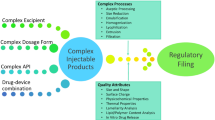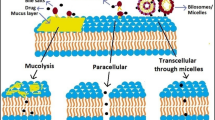Abstract
Semi-solid materials represent an important category of inactive ingredients (excipients) of pharmaceutical products. Here we review several common semisolid polymers currently used in the controlled release formulations of many drugs. These polymers are selected based on their importance and broad scope of application in FDA-approved drug products and include several polysaccharides (cellulose, starch, chitosan, alginate) and carbomers, a group of mucoadhesive synthetic polymers. Glyceride-based polymers used in self-emulsifying drug delivery systems (SEDDS) will also be discussed for its importance in formulating poorly water-soluble drugs. Unique features and advantages of each type of semi-solid materials are discussed and examples of their use in oral delivery of drugs are provided. Finally, future prospects of developing new and better semi-solid excipients are discussed with the objective of facilitating clinical translation.
Similar content being viewed by others
References
Langer R, Tirrell D A. Designing materials for biology and medicine. Nature, 2004, 428(6982): 487–492
Benson H, Watkinson A. Topical and Transdermal Drug Delivery: Principles and Practice. Hoboken, NJ: John Wiley & Sons, 2012, 1–407
Niazi S. Handbook of Pharmaceutical Manufacturing Formulations, Semisolid Products, Volume 4. Florida: CRC Press, 2004
Vashist A, Vashist A, Gupta Y K, Ahmad S. Recent advances in hydrogel based drug delivery systems for the human body. Journal of Material Chemistry B, 2013, 2(2): 147–166
Varde N K, Pack D W. Microspheres for controlled release drug delivery. Expert Opinion on Biological Therapy, 2004, 4(1): 35–51
Bao G, Mitragotri S, Tong S. Multifunctional nanoparticles for drug delivery and molecular imaging. Annual Review of Biomedical Engineering, 2013, 15(1): 253–282
Allen T M, Cullis P R. Liposomal drug delivery systems: from concept to clinical applications. Advanced Drug Delivery Reviews, 2013, 65(1): 36–48
Edgar K J. Cellulose esters in drug delivery. Cellulose, 2006, 14(1): 49–64
Ravenelle F, Rahmouni M. High-Amylose Starch for Controlled Drug Delivery. Polysaccharides for Drug Delivery and Pharmaceutical Applications. ACS Symposium Series 934, American Chemical Society, 2006, Chapter 4, 79–104
Bernkop-Schnürch A, Dünnhaupt S. Chitosan-based drug delivery systems. European Journal of Pharmaceutics and Biopharmaceutics, 2012, 81(3): 463–469
Tønnesen H H, Karlsen J. Alginate in drug delivery systems. Drug Development and Industrial Pharmacy, 2002, 28(6): 621–630
Singla A K, Chawla M, Singh A. Potential applications of carbomer in oral mucoadhesive controlled drug delivery system: a review. Drug Development and Industrial Pharmacy, 2000, 26(9): 913–924
da Fonseca Antunes A B, De Geest B G, Vervaet C, Remon J P. Gelucire 44/14 based immediate release formulations for poorly water-soluble drugs. Drug Development and Industrial Pharmacy, 2013, 39(5): 791–798
Hashida M, Takakura Y. Pharmacokinetics in design of polymeric drug delivery systems. Journal of Controlled Release, 1994, 31(2): 163–171
Karsa D, Stephenson R. Excipients and Delivery Systems for Pharmaceutical Formulations. Cambridge: Royal Society of Chemistry, 1995, 36–189
Wasan K. Role of Lipid Excipients in Modifying Oral and Parenteral Drug Delivery. Hoboken, NJ: John Wiley & Sons, 2007, 1–196
Tang B, Cheng G, Gu J C, Xu C H. Development of solid self-emulsifying drug delivery systems: preparation techniques and dosage forms. Drug Discovery Today, 2008, 13(13–14): 606–612
Liu H, Ilevbare G A, Cherniawski B P, Ritchie E T, Taylor L S, Edgar K J. Synthesis and structure-property evaluation of cellulose ω-carboxyesters for amorphous solid dispersions. Carbohydrate Polymers, 2014, 100: 116–125
Cui L, Jia J, Guo Y, Liu Y, Zhu P. Preparation and characterization of IPN hydrogels composed of chitosan and gelatin cross-linked by genipin. Carbohydrate Polymers, 2014, 99(2): 31–38
Liechty W B, Kryscio D R, Slaughter B V, Peppas N A. Polymers for drug delivery systems. Annual Review of Chemical and Biomolecular Engineering, 2010, 1(1): 149–173
Marchessault R, Ravenelle F, Zhu X. Polysaccharides for Drug Delivery and Pharmaceutical Applications. Washington, DC: American Chemical Society, 2006, 19–339
Pouton C W. Formulation of poorly water-soluble drugs for oral administration: physicochemical and physiological issues and the lipid formulation classification system. European Journal of Pharmaceutical Sciences, 2006, 29(3–4): 278–287
Pouton C W, Porter C J. Formulation of lipid-based delivery systems for oral administration: materials, methods and strategies. Advanced Drug Delivery Reviews, 2008, 60(6): 625–637
Ilevbare G A, Liu H, Edgar K J, Taylor L S. Impact of polymers on crystal growth rate of structurally diverse compounds from aqueous solution. Molecular Pharmaceutics, 2013, 10(6): 2381–2393
Wilson C, Crowley P. Controlled Release in Oral Drug Delivery. New York: Springer, 2011, 1–412
Badwaik H R, Giri T K, Nakhate K T, Kashyap P, Tripathi D K. Xanthan gum and its derivatives as a potential bio-polymeric carrier for drug delivery system. Current Drug Delivery, 2013, 10(5): 587–600
Wen H, Park K. Oral Controlled Release Formulation Design and Drug Delivery: Theory to Practice. John Wiley & Sons, 2010, Chapter 5
Li Z, Kozlowski B M, Chang E P. Analysis of aldehydes in excipients used in liquid/semi-solid formulations by gas chromatography-negative chemical ionization mass spectrometry. Journal of Chromatography A, 2007, 1160(1–2): 299–305
Gursoy R N, Benita S. Self-emulsifying drug delivery systems (SEDDS) for improved oral delivery of lipophilic drugs. Biomedicine and Pharmacotherapy, 2004, 58(3): 173–182
Patel P V, Patel H K, Mehta T A, Panchal S S. Self microemulsifying drug delivery system of tacrolimus: Formulation, in vitro evaluation and stability studies. International Journal of Pharmaceutical Investigation, 2013, 3(2): 95–104
Fernandez S, Rodier J, Ritter N, Mahler B, Demarne F, Carrière F, Jannin V. Lipolysis of the semi-solid self-emulsifying excipient gelucire® 44/14 by digestive lipases. Molecular and Cell Biology of Lipids, 2008, 1781(8): 367–375
Inactive ingredient search for approved drug products. Inactive ingredients in FDA approved drugs. US Department of Health & Human Services. 21 Sept. 2013, http://www.accessdata.fda.gov/scripts/cder/iig/index.cfm
Burgess B E. Optimizing drug delivery for modern biologics. BioPharm International, 2012, 25(5): 30–32
Koo O M Y, Varia S A. Case studies with new excipients: development, implementation and regulatory approval. Therapeutic Delivery, 2011, 2(7): 949–956
Amsden B G. Liquid, injectable, hydrophobic and biodegradable polymers as drug delivery vehicles. Macromolecular Bioscience, 2010, 10(8): 825–835
Rigo M V, Allemandi D A, Manzo R H. Swellable drug-polyelectrolyte matrices (SDPM) of alginic acid characterization and delivery properties. International Journal of Pharmaceutics, 2006, 322(1–2): 36–43
Wan J. Microfluidic-based synthesis of hydrogel particles for cell microencapsulation and cell based-drug delivery. Polymers, 2012, 4(4): 1084–1108
Heller J. Patient-friendly bioerodible drug delivery systems. Journal of Controlled Release, 2009, 133(2): 88–89
Nicolas J, Mura S, Brambilla D, Mackiewicz N, Couvreur P. Design, functionalization strategies and biomedical applications of targeted biodegradable/biocompatible polymer-based nanocarriers for drug delivery. Chemical Society Reviews, 2013, 42(3): 1147–1235
Salamat-Miller N, Chittchang M, Johnston T P. The use of mucoadhesive polymers in buccal drug delivery. Advanced Drug Delivery Reviews, 2005, 57(11): 1666–1691
Author information
Authors and Affiliations
Corresponding author
Rights and permissions
About this article
Cite this article
Tran, M., Wang, C. Semi-solid materials for controlled release drug formulation: current status and future prospects. Front. Chem. Sci. Eng. 8, 225–232 (2014). https://doi.org/10.1007/s11705-014-1429-7
Received:
Accepted:
Published:
Issue Date:
DOI: https://doi.org/10.1007/s11705-014-1429-7




